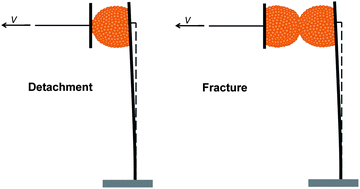Detachment and fracture of cellular aggregates†
Abstract
The dynamics of cellular adhesion and deadhesion, which play key roles in many cellular processes, have most often been studied at the scale of single bonds or single cells. However, multicellular adhesion and deadhesion are also central processes in tissue mechanics, morphogenesis, and pathophysiology, where collective tissue phenomena may introduce additional effects that are absent at the single-cell level. In this paper we present experiments on the adhesion of cellular aggregates and a laboratory model system to study tissue mechanics. We introduce a technique to measure the forces and energies involved in the detachment of an aggregate from a substrate (which can be viewed as a cellular tack assay) and in the fracture between two partially fused aggregates, as a function of the adhesion time, the pulling speed, and the cadherin density at the cell surface. We develop a model based on


 Please wait while we load your content...
Please wait while we load your content...